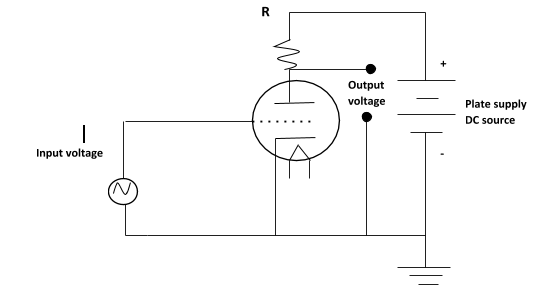
When a triode is used as an amplifier the phase difference between the input signal voltage and output is:
A) Zero
B) π
C) π/2
D) π/3
Answer
219k+ views
Hint: The low-voltage AC signal connected between the grid and cathode alternately suppresses, then enhances the electron flow between the cathode and plate. This causes a change in voltage on the output of the circuit. The AC voltage and current magnitudes on the tube’s grid are generally quite small compared to the variation of voltage and current in the plate circuit. Thus, the triode functions as an amplifier.

Complete step by step answer:
We know that voltage gain A
$A = \mu {R_L}/({R_L} + {r_p})$……………… (i)
rp =dynamic plate resistance
RL=Load resistance
µ= amplification factor
The amplification factor µ of a triode valve/vacuum tube is a measure of the relative effectiveness of the grid and anode voltages in producing the electrostatic fields at the surface of the cathode.
$\mu = - \dfrac{{\Delta {V_p}}}{{\Delta {V_G}}}$
Substituting the value of $\mu $in eqn(i)
We get $A = - \dfrac{{\Delta {V_p} \times {R_L}}}{{\Delta {V_G} \times ({R_L} + {r_p})}}$
Here,
ΔVp= change in phase voltage
ΔVG= change in grid voltage
The negative sign here shows that input voltage and output voltage are out of phase and out of phase means that the difference between the input voltage signal and the output voltage signal is 180 degrees and we know that in ${180^0} = \pi $radian.
Hence, Option (B) the correct answer.
Note: The triode valve or triode vacuum tube takes the basic concept of the diode and moves it on a significant stage further. A third electrode called a grid or more correctly a control grid is placed between the cathode and anode of the basic diode and by applying a potential to the grid, it is possible to repel or attract the electrons being emitted from the cathode and in this way affect the flow between cathode and anode of the triode vacuum tube.

Complete step by step answer:
We know that voltage gain A
$A = \mu {R_L}/({R_L} + {r_p})$……………… (i)
rp =dynamic plate resistance
RL=Load resistance
µ= amplification factor
The amplification factor µ of a triode valve/vacuum tube is a measure of the relative effectiveness of the grid and anode voltages in producing the electrostatic fields at the surface of the cathode.
$\mu = - \dfrac{{\Delta {V_p}}}{{\Delta {V_G}}}$
Substituting the value of $\mu $in eqn(i)
We get $A = - \dfrac{{\Delta {V_p} \times {R_L}}}{{\Delta {V_G} \times ({R_L} + {r_p})}}$
Here,
ΔVp= change in phase voltage
ΔVG= change in grid voltage
The negative sign here shows that input voltage and output voltage are out of phase and out of phase means that the difference between the input voltage signal and the output voltage signal is 180 degrees and we know that in ${180^0} = \pi $radian.
Hence, Option (B) the correct answer.
Note: The triode valve or triode vacuum tube takes the basic concept of the diode and moves it on a significant stage further. A third electrode called a grid or more correctly a control grid is placed between the cathode and anode of the basic diode and by applying a potential to the grid, it is possible to repel or attract the electrons being emitted from the cathode and in this way affect the flow between cathode and anode of the triode vacuum tube.
Recently Updated Pages
A square frame of side 10 cm and a long straight wire class 12 physics JEE_Main

The work done in slowly moving an electron of charge class 12 physics JEE_Main

Two identical charged spheres suspended from a common class 12 physics JEE_Main

According to Bohrs theory the timeaveraged magnetic class 12 physics JEE_Main

ill in the blanks Pure tungsten has A Low resistivity class 12 physics JEE_Main

The value of the resistor RS needed in the DC voltage class 12 physics JEE_Main

Trending doubts
JEE Main 2026: Application Form Open, Exam Dates, Syllabus, Eligibility & Question Papers

Understanding Uniform Acceleration in Physics

Derivation of Equation of Trajectory Explained for Students

Hybridisation in Chemistry – Concept, Types & Applications

Understanding the Angle of Deviation in a Prism

Understanding Collisions: Types and Examples for Students

Other Pages
JEE Advanced Marks vs Ranks 2025: Understanding Category-wise Qualifying Marks and Previous Year Cut-offs

Understanding Atomic Structure for Beginners

How to Convert a Galvanometer into an Ammeter or Voltmeter

Understanding Centrifugal Force in Physics

JEE Main Marking Scheme 2026- Paper-Wise Marks Distribution and Negative Marking Details

Degree of Dissociation: Meaning, Formula, Calculation & Uses




